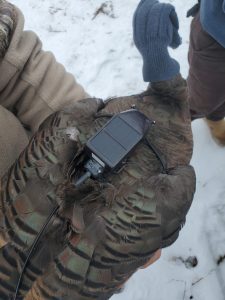Researchers looking for insight into wild turkey population decline
January 15th, 2024 by Ric Hanson
(Iowa DNR/Manchester, IA) – The reintroduction of wild turkeys to Iowa’s landscape has been celebrated as a conservation success story for the past 25 years. But Iowa’s turkey population is showing troubling signs: the numbers are down, nests are failing and fewer poults are surviving. And it’s not just an Iowa problem – turkey populations are declining in all states in the Midwest and across the eastern half of the United States. The Iowa Department of Natural Resources (DNR) says a group of midwestern states met in North Dakota in 2023 to discuss turkey population concerns and projects that are planned and underway. Missouri has had a decades long study, while Ohio, Nebraska and Wisconsin are all in the early stages of projects. In the southeast, Tennessee is looking at harvest seasons impacts and Auburn University is looking at male fertility rates in Alabama, and there are more.
In 2022, the DNR began a 10-year study of the turkey population in southeast Iowa to learn more about why the numbers are declining. Now entering its third year, researchers may have more questions than answers. Dan Kaminski, wildlife research biologist with the Iowa DNR, is leading the study and what Kaminski and his fellow researchers have learned is that only around 60 percent of Iowa hens survive annually. Of the hens that are alive on April 15, roughly 25 percent will not nest, which is above what other researchers are finding in other parts of the country. Researchers observed 60 nests last summer and documented 10 nests that hatched. Of those 10 nests, only 30 percent of the broods survived at least one poult into August. All of the unhatched eggs collected from lost nests were sent to the University of Tennessee for examination and all were determined to have been fertilized.
“These are concerning findings, but the study only goes back two years,” Kaminski said. “The ten-year study will get us out of any short-term weather patterns that affect turkeys and provide clearer long-term data trends.”

Hen turkey outfitted with a transmitter as part of the 10-year Iowa turkey population study. Photo courtesy of the Iowa DNR.
So, what is killing them? Environmental factors? Lack of available food? Predators? Abandonment?
The Project
Researchers in Wisconsin found that to sustain its current population, hen turkeys need to average 2.6 poults per hen. The recent trend in Iowa’s summer turkey brood survey has hens averaging two poults per hen. To find out what is causing nest failures, poult mortality and why a quarter of the hens are not even attempting to incubate a nest, researchers will be catching hens in late January and February, outfitting them with transmitters and releasing them. “Cold and snowy conditions are best – that will group up the birds,” he said. “Our local staff have trail cameras set up at wintering sites and once the birds show up, we head to the sites and trap the birds.”
Nesting season begins in late April, peaks around May 20, and ends in mid-July. Turkeys nest on the ground, usually in dense vegetation underneath shrubs or trees in overgrown fields or mature forests, relying on their natural camouflage to avoid predators. The transmitters update hen location every 15 minutes and once it appears hens are on a nest, Kaminski will mark and date the location, and then wait. Hens will lay one egg every day-to-day-and-a-half, averaging 12-14 eggs per clutch. Eggs incubate for 28-30 days before hatching. After hatch, little by little, she will slowly begin to move her brood away from the nesting site. Once she is on the move, researchers will go in to check nesting success, collect any unhatched eggs as well as any eggs that appear to have been broken or eaten.
“With the new technology – the satellites and gps – it makes collecting highly detailed data much more available,” he said. “When birds set up nests we want to know about it – if it fails, is predated, or abandoned, we want to know ASAP – we want to get to the nest to see what happened and collect the eggs for analysis.” This year, they will attempt to catch 83 adult and juvenile hens across all sites in Lucas, Van Buren, Louisa and Jackson counties. These birds will join the roughly 55 birds that are currently “on the air.” The goal is to maintain 25 birds with transmitters in each county.
The study area is a mosaic of grassland, agriculture and timber that should be producing turkeys – but is not. And the issue is not isolated to southeast Iowa, other well-known turkey spots in northeast Iowa and the Loess Hills are also seeing the same declines. “But those areas started with more birds so the population decline isn’t as obvious,” he said.
Looking for answers
“We get comments at public meetings and through social media focusing on bobcats, eagles, coyotes and other predators as the reason for the population decline. Poults are ground bound and vulnerable for the first four weeks before they can roost in a tree so there is no question that predators impact turkeys through nest predation and poult predation. But this long-term decline goes back to pre-bobcat days, back before the fur market crashed in 2015, before carnivore populations increased,” he said. “The population decline likely began in the late 1980s and it may simply be due to a changing landscape that has less carrying capacity and that this is just nature’s way of finding a new normal for the population. However, it is probably a combination of factors. Predation is an obvious cause to detect; what we don’t want to do is miss one of the other factors.”
It could involve habitat loss. It could also involve a new disease. That new disease – Lymphoproliferative Disease Virus (LPDV) – was first detected in North America in 2009 in Arkansas and has since been found across the Eastern U.S. and statewide in Iowa. Lymphoproliferative Disease Virus has been studied by the domestic poultry industry which found that chicks and poults die within six weeks of contracting it. “The question is, can an LPDV positive wild hen pass the disease on to her poults? We don’t know. We also don’t know if it’s 100 percent fatal in the wild like it is with domestic poultry,” he said. LPDV is not known to be a health concern for humans.
There are other theories being explored in other regions of the country. Some research in the southeast U.S. is looking at the timing of the hunting seasons potentially disrupting breeding and removing dominant birds from the population before they can pass on their genetics. But Kaminski has his doubts. “We’re not sure about this theory but it is being discussed,” he said. “Our study doesn’t include males so I’m interested in what they find. More so than genetics, it may be that early and prolonged disturbance during the egg laying period is disrupting hens.”
Whatever factors are causing the decline, Iowa still has a dynamic population of the iconic bird in every county in the state. “We just came off a record harvest in 2023,” he said. “We still have a vibrant turkey population and when the nesting conditions are right, the population can really jump.” Data collected from this project will be used to build population models and habitat models that will provide researchers some understanding and guidance in ways to improve populations.
Landowners, partners play key role in project
“The project would not happen without cooperation with private landowners,” said Kaminski. “Public support to allow us to come out, investigate nest sites and collect carcasses – that support is critical for this to be a success.” The project involved 20 staff from the Iowa DNR’s Wildlife Bureau and buy in from local private landowners in four counties. Project funding is supported by grants from Iowa State University – Fish and Wildlife Co-op Unit, the state and national National Wild Turkey Federation and Turkeys for Tomorrow. Luther College is conducting genetics work and the DNR is working with the USGS National Wildlife Research Center in Fort Collins, Colo.





